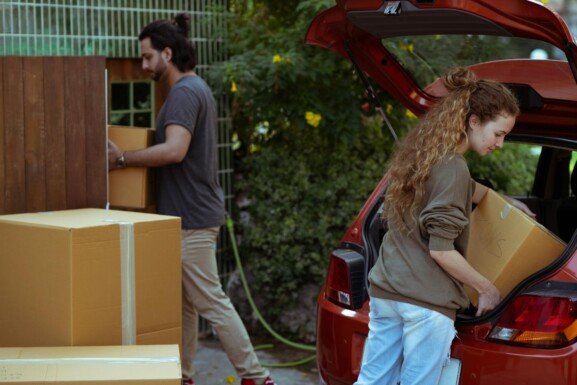Moving to the USA: The Real Cost of Starting Fresh
Thousands of people move to the United States every year. Some go for work, some for school, while others just want to join family. Whatever the reason, one thing is certain: relocating isn’t cheap. The U.S. has a reputation for high living costs, but the real expense starts long before you sign a lease or step into a grocery store.
International moving is not an easy project, but it does touch every part of your life since it you need to travel, set up paperwork, get insurance, shipping, and eventually set up a home. If you don’t know what to expect, it’s easy to underestimate how much money you’ll need.
This guide lays out the numbers in plain language. We’ll cover upfront costs like flights and visas, the price of shipping your belongings, what life actually costs in U.S. cities, and how to budget so you’re not left scrambling.
The First Hit: Upfront Costs You Can’t Escape
Before you unpack a single bag, you’ll face a wave of upfront expenses. Here are the non-negotiables when it comes to moving to the USA: flights, visa fees, and insurance.
Flights
Plane tickets take a big chunk of the budget, especially for families. Prices depend on where you’re flying from:
- From Asia to the U.S., one-way tickets usually cost $600–$1,200 per person.
- From Europe, tickets range $400–$800.
- From South America, prices sit around $500–$900.
How much do one-way flights cost to the U.S. from my country? It would cost about $2,000–$4,000 if you are with a spouse and two kids. That’s how it would burn through the finances; not to mention luggage fees. Booking early and flying off-season helps, but this is one cost you can’t avoid.
Visa Fees
The type of visa you apply for makes a huge difference and this is the first level step that you need to take a look at before moving.
- Tourist visa (B1/B2) is about $160
- Work visas (H-1B, L-1, O-1, etc.) is around $190–$500 in filing fees
- Green card through family or work could be about $1,200–$2,000 in government fees
- Immigration lawyer fees is $1,000–$5,000 if you need professional help
For many – visas end up being one of the most unpredictable costs. Thus, it would be wise to budget more than you think you’ll need because delays, reapplications, or legal help often pop up.
Insurance
The U.S has the most expensive healthcare system that even if it is just a minor hospital visit, it could cost you a couple of thousands. For new arrivals, the options are:
- Short-term expat insurance: $150–$250 per month
- Full health insurance plans: $400–$600 per month per person
- Family coverage: $1,200–$2,000 per month
This is an ongoing cost, but you’ll need coverage immediately. Many airlines even ask for proof of insurance at check-in.
Bottom line: Between flights, visas, and insurance, most expats should set aside at least $3,000–$5,000 before they arrive in the U.S. Families will need much more.
The Big Question: How Much Does Shipping Cost?
You may ask, should I ship my furniture or buy new when moving to the USA? Well, when you have the paperwork then you’ll face the challenge of moving your life across the ocean. Shipping isn’t just about containers; it covers household goods, cars, and pets.

Household Items
International moving services price shipments by volume and distance.
- 20-foot container: $5,000–$8,000. Suitable for a small apartment or a two-bedroom home.
- 40-foot container: $10,000–$15,000. Needed for larger households.
- Air freight: Much faster but costs double or triple sea freight rates.
Delivery times vary from four weeks to three months. Customs duties and port fees can add another $500–$1,000.
Many expats ask themselves if it’s worth shipping furniture at all. For smaller moves, selling old items and buying new ones in the U.S. can be cheaper than paying to ship everything.
Vehicles
Shipping a car ranges from $1,500–$3,000, but that’s just the start. You’ll also pay for port handling, customs, and possibly modifications to meet U.S. safety and emissions standards. In some cases, those modifications cost more than the car itself.
Pets
For many, it is not an option to leave pets behind however flying with a pet costs $300–$500 for the airline fee. You also need to add veterinary exams, vaccines, and import paperwork, and the total climbs to $800–$1,200 per animal. Some states also have quarantine requirements, which increase both cost and stress.
Hiring a Moving Company
You simply cannot do this alone because this will overwhelm you. Leading international moving companies handle packing, paperwork, customs, and delivery. Of course, convenience comes at a price. But if you’re shipping a household, hiring movers is often worth it. For those carrying just a few suitcases, luggage shipping services or extra baggage fees may be cheaper.
Living Costs Once You Arrive

The real adjustment begins when you start living in the U.S. even after paying the big upfront bills. The cost of living is different and this usually depends on where you move. Here are some living costs you should know:
New York City
- Rent: $2,500–$3,500 which is a one-bedroom in Manhattan.
- Groceries and dining out: $600–$900 per month
- Transport such as subway, taxis, Uber: $150–$250
- Monthly total (single): $3,800–$4,500
Families spend far more. Childcare alone can cost $2,000 per month per child.
Los Angeles
- Rent: $2,000–$2,800 for a one-bedroom
- Groceries and dining: $500–$800
- Car costs (gas, insurance, maintenance): $400–$600
- Monthly total (single): $3,200–$3,500
Cars are essential in LA and this adds to the costs compared to New York’s public transport system.
Texas (Austin, Dallas, Houston)
- Rent: $1,200–$1,800 for a one-bedroom
- Groceries: $400–$600
- Car expenses: $300–$500
- Monthly total (single): $2,200–$2,700
Texas does offer one of the best options in terms of affordability and job opportunities for you. Many of those who move chose this place as their sweet landing spot.
Florida (Miami, Orlando, Tampa)
- Rent: $1,500–$2,200 for a one-bedroom
- Groceries and dining: $400–$700
- Transport: $200–$400 depending on car use
- Monthly total (single): $2,800–$3,200
Remember this, too – Miami skews more expensive but smaller cities like Orlando and Tampa are manageable.
Budgeting Tips That Actually Work
It is expensive when you relocate, this is true. However, you can plan smartly to keep it under control.
- Save for six months of expenses. You need a financial cushion until your income stabilizes. If you are single, then you need to aim for $15,000–$25,000 in savings. Families should target $35,000–$50,000.
- Bring less stuff. Every extra box costs money so think about what’s worth shipping and what’s easier to replace. Many people regret paying thousands to move furniture only to realize it doesn’t fit in U.S. homes.
- Research cities carefully. You should not assume that New York or LA is your only option. Mid-size cities offer affordable rent and good job markets.
- Plan healthcare early. Factor in health insurance before you arrive. This will help you prevent financial shocks from unexpected medical bills.
- Use movers when it makes sense. If you’re relocating an entire household, a leading international moving company is worth the expense. But if you’re arriving with clothes, laptops, and essentials, you may not need one.
Moving to the USA: How Much Do You Need?
With all of that comes to mind, your budget now looks like this:
- Singles: Around $20,000 is a good starting point. This amount covers flights, visas, insurance, shipping essentials, and at least a few months of rent and food.
- Couples: Around $30,000–$35,000, yet this one depends on the lifestyle.
- Families with kids: At least $40,000–$50,000 which covers rent, school, insurance, and shipping.
Every situation is different so the best thing to do is to keep these numbers in mind. They may not be the “exact” prediction for you, but it can still give you a realistic picture of what it costs to move and settle.
Final Thoughts
pay for flights, visas, and insurance before you even leave your home country. Then there’s the decision about whether to ship furniture, cars, or pets. Once you arrive, rent and healthcare take center stage.
The good news is that knowing the numbers helps you plan better. You don’t need to guess. Set a realistic budget, keep your savings cushion, and be clear about what you’ll bring and where you’ll live.
If you’re preparing for your own international moving journey, platforms like Outplore can connect you with guides, resources, and communities that make the transition smoother.
FAQ: Moving to the USA
1. What’s the average cost of moving from Asia or Europe to the U.S.?
Hard to pin down because it depends on what kind of life you’re setting up. If you’re the backpack-and-laptop type, your main expense might be the plane ticket ($400–$1,200 usually). But that’s just entry level. You’ll also need to budget for the visa, a temporary place to stay, maybe health coverage, plus the first round of deposits. People who move alone and live modestly often say they spent somewhere in the $15k–$25k range by the time they felt “settled.” Families? More like $40k–$60k, sometimes higher if kids are in school.
2. Is it cheaper to ship furniture or buy new once you’re in the U.S.?
Depends how attached you are to your stuff. A lot of people ditch furniture and just buy fresh after arriving (Ikea, Facebook Marketplace, second-hand stores). It’s less hassle, especially if you’re only bringing clothes and a few gadgets. But if you already own a fully furnished home—beds, couches, dining set—then shipping can actually save money long-term. And sentimental items? Definitely worth shipping, even if the math doesn’t make sense.
3. Which U.S. cities are easier on the wallet?
The famous big three—New York, San Francisco, LA—look great in movies but are brutal on rent and groceries. That’s why so many newcomers end up in Texas (Austin, Dallas, Houston) or Florida (Tampa, Orlando, Miami suburbs). Lower housing, decent jobs, and you don’t freeze in winter. A few even try Midwest cities like Minneapolis or Kansas City for cheaper living, though the weather is a different story.
4. How much money should I really have before leaving?
Think of it like a buffer. Three to six months’ living costs in cash or savings is the usual advice. For a single mover, $20k feels like a comfortable cushion. Couples or families should double that—$40k–$50k—so they’re not stressed about rent deposits, utilities, school fees, or random surprises (like a car repair two weeks after you arrive).
5. Do I need health insurance before stepping foot in the U.S.?
Yes. One of the worst rookie mistakes is showing up without coverage. The U.S. has amazing hospitals, but the bill for something simple—like a broken arm or an overnight stay—can wipe out your savings. It’s not optional, it’s survival. If your employer doesn’t sort it out, buy something short-term before you leave.
6. How does Outplore fit into this?
It’s not a moving company with trucks. Outplore is more like a guidebook plus a Rolodex. It gives you relocation info, visa breakdowns, and points you toward reliable service providers. Maybe even more useful, it connects you with expat groups so you’re not navigating everything alone. Think of it as the “friend who’s been there” when you don’t actually have one yet.



